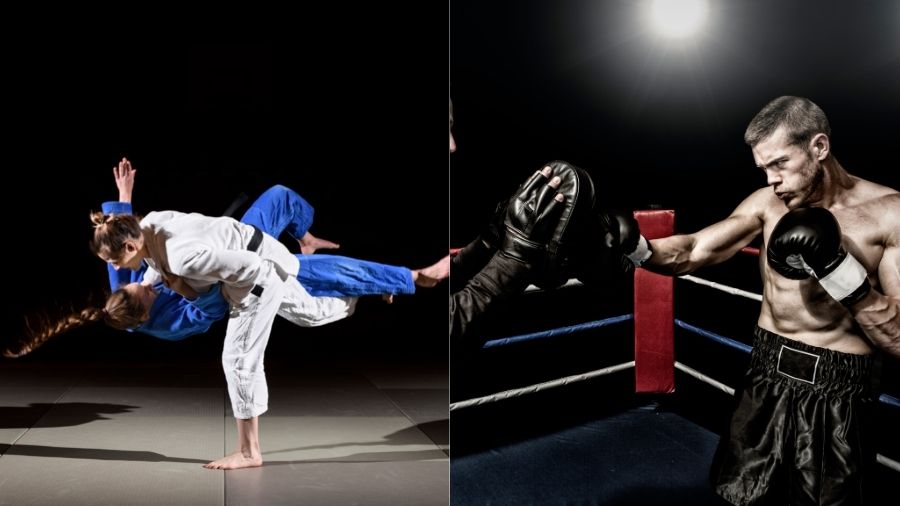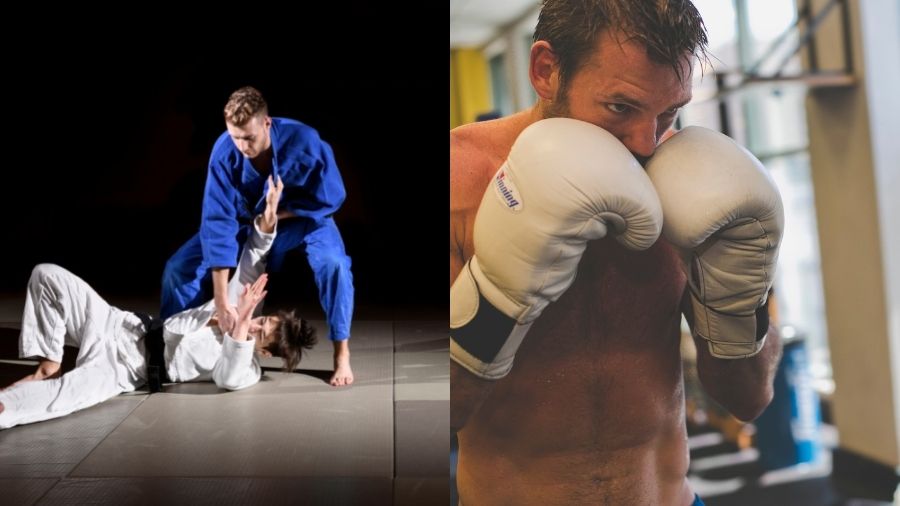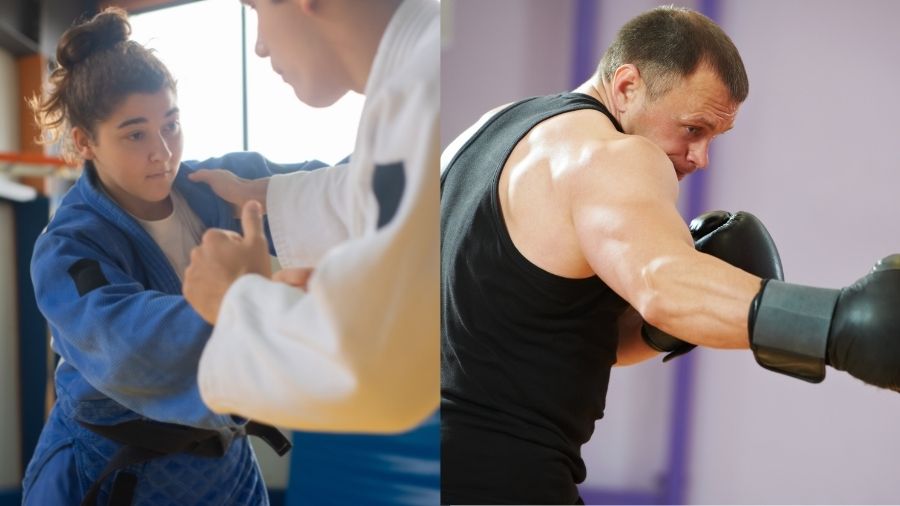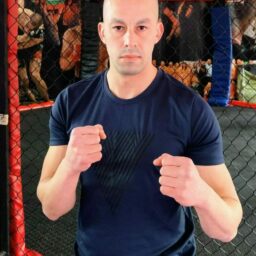Boxing and Judo have been an essential part of the combat sports family in the Olympic games. The two have more differences than things in common, but they often draw from the same talent pool, so it’s worth knowing what they offer.
Boxing is a striking combat sport where two opponents fight only using their fists and aim to knock out or outscore the opponent. In contrast, Judo is a grappling martial art and sport all about throwing and controlling the opponent on the ground.
A night and day difference, one would say, and would be right. Both, however, have a lot to offer, and the right choice would be to train in both and develop a well-rounded unarmed fighting skill set. The single-sentence answer is likely not sufficient for you, so let’s dive into these fine combat sports in more detail.
What Is Boxing?
Boxing is a combat sport that pits two fighters against each other in a fistfight. Modern boxing established the standard for most other combat sports, including dividing a fight into rounds, using padded gloves, using judges to score rounds, and many other innovations.
Boxing, also known as pugilism, has long been regarded as a gentlemanly form of combat.
The only strikes permitted in boxing are punches above the waist. Aside from punches, footwork and head movement are essential for boxing success.
This results in a particular type of combat requiring both creativity and precision. Because of the emphasis on tactics and strategy at the higher levels of competition, boxing is affectionately called “the sweet science.”
Fist fighting is one of the oldest sports globally, and we have evidence of a form of boxing from ancient Egypt dating back to around 3000 BC.

How to Dominate Every Fight with Raw, Explosive Power No One Can Match
Discover the underground blueprint that has quietly turned MMA hopefuls into legends, using nothing but sheer, brute force and bulletproof conditioning techniques.
However, the modern version of the sport was created a lot sooner. It began as bare fist fighting in the 17th century in England until it finally took the form we know today with the acceptance of the Queensbury Rules in 1867.
What Is Judo?
Judo is a grappling-based martial art and combat sport, with the object of throwing the opponent to the ground, immobilizing or submitting him. In the traditional form, there was a small striking element. Still, the focus has always been on throwing and ground control.
Japanese martial arts master Jigoro Kano created Judo. He transformed his skills and knowledge of traditional jiu-jitsu into what became Judo. Kano created his art around 1880 with one main motto in mind- maximum efficiency with minimum effort.
His creation’s philosophy and training methodology became the blueprint for almost all modern Japanese martial arts created in the 20th century.
Essential for success in Judo is the principle of breaking the opponent’s balance, called kuzushi. All throws are done by manipulating the center of gravity of the opponent. On the receiving end, a key element is effectively breaking the falls.
Judo practice and competition are always done while wearing a special uniform called a judogi. The judogi is essential to the strategies and tactics of Judo as it is constantly used for gripping.
Judo is part of the Olympics, and the sports ruleset took away many integral pieces of the martial art. The Olympic committee gradually implemented rules aiming to make the sport “more exciting,” but in reality, reduced the noble martial art into a husk of what it once was.
Initially, standing submissions were allowed but were banned in sports Judo. In the original art, submissions were made against most joints in the body, while today, most of them are eliminated.
The only submissions currently permitted are straight arm locks and chokes (but not all chokes). The most controversial rule that changed sports judo was the ban on touching the legs of the opponent while throwing or defending.
Key Differences Between Boxing and Judo

Techniques
Boxing and Judo take opposite approaches to combat. Boxing limits its practitioners to using only punches—straights, hooks, and uppercuts—and boxers take what is given to them to perfection.
Footwork and distance management are essential, as is proper positioning in relation to the opponent.
On the other hand, Judo has no strikes whatsoever, and it does all its work in close quarters. Judo splits its arsenal into distinct categories.
Nage Waza are throwing techniques (divided into standing throws and sacrificing throws), including hip throws, shoulder throws, and various sweeps and trips.
The ground techniques are called Katame Waza. There are two main types- controlling techniques to pin the opponent down and submissions.
In the second department, the sports ruleset allows a few strangulations and straight-arm locks only.
There are many more techniques in traditional Judo, both on the feet and on the ground. But most of them are banned from competition.
Equipment
The boxing gloves most other striking combat sports have adopted are the most essential piece of boxing gear. Special boxing shoes a mouthguard, and groin protection are required for training and fighting. Other than that, any comfortable clothes can do the job.
Judo is practiced in a traditional uniform called a judogi, comprised of a cotton jacket, canvas trousers, and a belt. The gi is mandatory and essential for training, not only for etiquette and tradition but also for gripping in most Judo techniques.
Competitive Landscape
Judo is part of the Olympic games and, as such, is highly competitive and has a well-developed competition circuit worldwide.
The Olympics are the highest podium, but there are also many other international competitions like continental and World Championships.
Like in every similar program, the road to the big stages begins with regional tournaments and gradually builds up.
Judo has millions of practitioners and is well-developed in most countries because it receives government funding because of its Olympic status.
Amateur boxing works the same way as Judo and is also an Olympic sport. But aside from this avenue, it has an even more popular professional aspect.
Boxing has been the premier combat sport in the West since the start of the 20th century and remains an integral part of popular culture.
Elite pro boxers become celebrities, and the fight purses at the high levels are worth millions of dollars.
Money, fame, and glory attract many competitors, and becoming a world champion in boxing is one of the highest possible achievements a fighter can reach.
Strength & Conditioning
Strength training between grappling and striking sports differ greatly. Striking arts tend to fall more on the velocity side while grappling arts tend to be more strength orientated. For example, strength training for boxing will focus on jumps, throws, plyometrics, and other explosive lifting with less volume of heavy resistance exercise.
On the other hand, Judo strength training will have the same elements with slightly more emphasis on heavy resistance exercise with jumps, throws, and plyometrics.
Both sports are based on work capacity and the ability to repeat high-intensity efforts. Boxing conditioning is steeped in tradition with long runs as it’s main form of energy system development.
However, higher intensity sprints are needed to develop the ability for muscles to reduce fatigue. Judo conditioning is similar with the most elite Judoka able to perform more throws in a certain time period.
Boxing vs. Judo for Self Defense

Judo is the forefather of modern Japanese martial arts. All of them were created with a few crucial pillars in mind, and self-defense was the central one. Early in its inception, it emphasized throws and ground control.
Still, strikes and defense against them were included, making it very effective for real-life defense. Competition is also an important part of Judo in self-defense application because it prepares the body and mind to fight against an unwilling and fully resisting opponent.
Physical strength and endurance are essential in Judo, so a skilled judoka is always in excellent fighting shape.
But as Judo progressed as a sport, many aspects of the martial art were removed. And with each rule change, Judo lost a bit of its practicality.
Practitioners usually want to compete, so traditional techniques and methods were let go, even in training, as they had no use in a match.
This, of course, does not mean Judo is not effective in self-defense. Control in the clinch is essential, as street fights often end there.
It’s no coincidence many police forces use Judo techniques because they offer great control without harming the detained person.
The primary deficiency of Judo for self-defense is the lack of striking. Once a judoka grabs hold of someone, they are in deep trouble, but before the grip is secured, things are different.
Another possible problem with the street effectiveness of Judo is the heavy reliance on the grip of the judogi.
People of today rarely wear clothes thick enough to grab and manipulate them effectively, and this strongly depends on the place and season.
The practicality of boxing in a street fight is undeniable. Punches are the fastest strikes that can be thrown and are usually the safest.
Landing a devastating one-two will end a fight very quickly. The competitive nature of boxing, even in training, prepares each practitioner for the feeling of getting hit and attacked aggressively.
The big downside of boxing is the lack of kicking and grappling, making it quite limited on the street.
Against untrained opponents, a boxer has an unsurmountable advantage, but against a person with some more well-rounded skills, the boxer will likely struggle with all the threats in front of them.
Is Learning Boxing And Judo The Ultimate Self-Defense Combo?
By now, everyone should be aware you need to know both some striking and grappling for self-defense. Real-life situations are unpredictable, and too many variables can be present. Even a well-rounded elite fighter can be surprised and beaten in the right circumstances.
Nevertheless, to have some well-backed confidence, you need to be able to handle your own at all ranges, and a combination of boxing and judo might be the best.
As I said, the downside of boxing is the lack of grappling, and the absence of striking is judo’s main flaw.
By learning both, you will be able to address most possible situations. Punching is the safest and most effective way to fight on the feet, and judo’s throws and control take care of the clinch aspect.
Once on the ground, judo may not have the expertise of BJJ, but the few available strangulations and joint locks in judo are more than enough against the vast majority of the population.
Other martial arts may provide more options on the feet and the ground. Still, boxing and Judo excel at what is proven most effective in real situations, where flashy techniques or methodical setups can be disastrous.
Boxing vs. Judo For MMA

Although MMA incorporates techniques from all martial arts, it is an entirely different game. Boxing and Judo both have a lot to offer in the cage, but everything has to be adjusted accordingly.
Boxing punches, head movement, and ring generalship are essential in MMA. Still, you must change the stance to respond to takedowns and low kicks and the defense to reflect the smaller gloves.
Due to the lack of corners, you must transform ring movement, and head movement must be subtler in case a knee or a kick is coming behind the slipped punch. Boxing, with enough modification, can provide some of the most valuable skills to MMA.
Fighters with a judo background frequently use trips, and most fighters are unprepared to defend them. Ronda Rousey’s trips and armbars single-handedly put women’s MMA on the map.
However, you must modify judo moves as well. With the gi no longer available, judokas must learn to use under and over hooks and other techniques to destabilize their opponents.
It’s safe to say boxing and judo skills are essential in the arsenal of a good MMA fighter, with boxing having a bit more importance as a whole.
Can Boxing Beat Judo?
Yes, it can. But it depends on too many details. Is there enough space for the boxer to move and keep a distance?
At what distance does the fight start? Can the boxer punch the judoka before he grabs him? Can the judoka keep a hold of the boxer if he wears only a t-shirt?
History and the internet have shown us that a pure grappler wins against a pure striker in a one-on-one fight. But there are just too many variables to predict every outcome.
Which Is Harder: Judo Or Boxing?

Both sports are physically demanding and highly competitive. They have different physical demands, but fighters must be in peak condition in both cases.
Olympic sports have always had very stiff competition. Both are still included in the Olympics, so reaching the top will require overcoming a huge talent pool.
Nonetheless, boxing is far more popular than Judo. There is a lot of money in professional boxing, and where there is money, more people are trying to get their hands on it. Getting to the top of boxing will be more complicated than getting to the top of Judo.
Compared to each other physically, both are very demanding. The requirements are different but equally challenging. With a good training regimen and an adequate diet, you will get into great shape regardless of your chosen sport.
Boxing vs. Judo – Which Should You Learn?
It all comes down to personal goals and motivations. Boxing is usually more accessible in the Western world, both for training and as a spectator sport.
Boxing has been a part of mainstream culture for over a century, and it’s easy to see why you’d want to give it a shot. But remember that boxing is a violent sport, and you will take several punches to the face even if you remain a hobbyist.
And if you are looking for a more traditional martial art with a strict philosophy and hierarchy, Judo is a good choice.
The softer approach to combat is also easier on the body and mind. Furthermore, the control of another person may give you the choice of how to resolve a conflict- more or less violently, while with boxing skills, your only option is to do damage.

